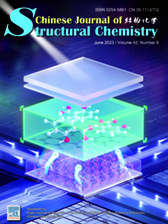
Cover Picture
UV-resistant salicylic acid as interface modifier for efficient and stable perovskite solar cells
Guo-Bin Xiao, Zihan Fang, Shengrong Yang*, Jing Cao*, Yu Tang* Submit a Manuscript
UV-resistant salicylic acid as interface modifier for efficient and stable perovskite solar cells
Guo-Bin Xiao, Zihan Fang, Shengrong Yang*, Jing Cao*, Yu Tang* Submit a Manuscript
A MOF-to-MOF conversion assisted formation of hierarchical hollow Zn-Co1-xS/C@C composite for efficient potassium-ion storage
Qixin Zhang, Lizhong Liu, Lulu Song, Chuxin Wu, Yi Zhao*, Lunhui Guan*
Chin. J. Struct. Chem., 2023, 42: 100092. DOI: 10.1016/j.cjsc.2023.100092
June 15, 2023
MOF conversion; Hollow structure; Cobalt sulfide; Element doping; Potassium-ion batteries
ABSTRACT
Hollow structured composite can enhance the structural stability of metal sulfide anode by accommodating its volume variation, while the performance is still hindered by its poor electron/ion conductivity. Herein, we develop a hierarchical hollow structure to achieve superior electrochemical performance, from which a MOF-to-MOF conversion is utilized to generate hollow Zn–Co1-xS/C composite followed with additional carbon coating layer. For potassium storage, as-prepared hollow Zn–Co1-xS/C@C composite displays high capacities of 375 mA h g−1 after 100 cycles at 0.2 A g−1 and 201 mA h g−1 after 500 cycles at 1 A g−1. Moreover, it also manifests outstanding rate capability of 200 mA h g−1 at 10 A g−1, outperforming hollow Co1-xS@C and majority of the reported cobalt-based anodes. With illustration by kinetics analysis and theoretical calculation, both of Zn doping and internal carbon matrix are conductive to promote the charge transportation ability of Co1-xS, thus accounting for the good cycling behavior and excellent rate capacity of hierarchical hollow Zn–Co1-xS/C@C composite.







